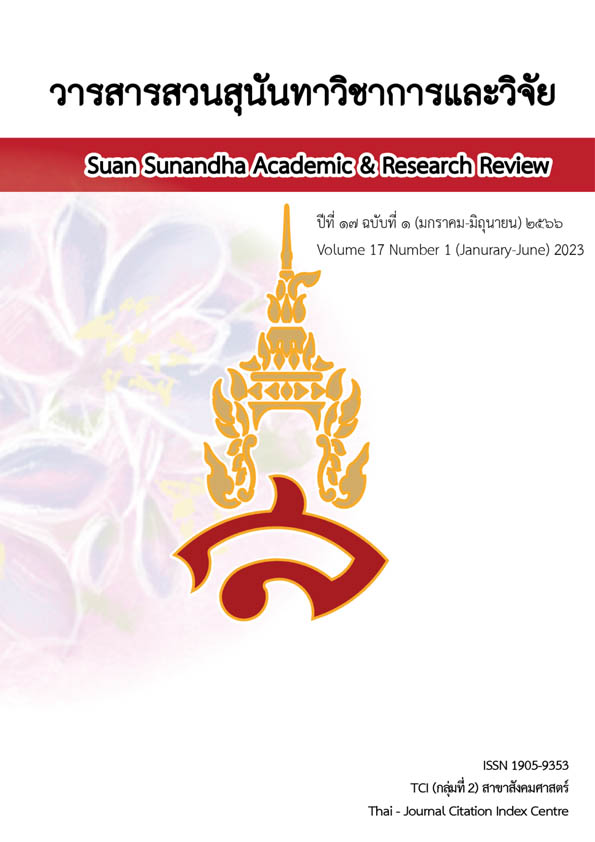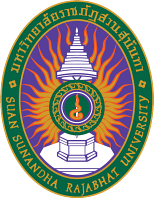ผลของชุดกิจกรรมที่มีต่อการเห็นคุณค่าในตนเองของ กลุ่มนักเรียนดุริยางค์ทหารอากาศ ชั้นปีที่ 3 โรงเรียนดุริยางค์ทหารอากาศ
คำสำคัญ:
การเห็นคุณค่าในตนเอง, ดนตรีศึกษา, นักเรียนดุริยางค์ทหารอากาศบทคัดย่อ
การวิจัยครั้งนี้มีวัตถุประสงค์เพื่อศึกษาผลของชุดกิจกรรมที่มีต่อการเห็นคุณค่าในตนเองของนักเรียนดุริยางค์ทหารอากาศ ชั้นปีที่ 3 โรงเรียนดุริยางค์ทหารอากาศ การวิจัยในครั้งนี้เป็นการวิจัยกึ่งทดลองแบบกลุ่มเดียว กลุ่มตัวอย่างที่ใช้ในการวิจัย คือ นักเรียนดุริยางค์ทหารอากาศ ชั้นปีที่ 3 จำนวน 14 คน โดยมีการประเมินก่อน-หลังการทดลอง เครื่องมือที่ใช้ในการวิจัย คือ ชุดกิจกรรมที่มีต่อการเห็นคุณค่าในตนเองของนักเรียนดุริยางค์ทหารอากาศ ประกอบด้วยการจัดกิจกรรมทั้งหมด 6 ครั้ง (ครั้งละ 2 ชั่วโมง) และแบบวัดการเห็นคุณค่าในตนเองของโรเซนเบิร์ก ฉบับภาษาไทย (Rosenberg Self-Esteem Scale Thai Revised: RSES-TR-10) วิเคราะห์ข้อมูลโดยใช้ร้อยละ ค่าเฉลี่ย ค่าเบี่ยงเบนมาตรฐาน การทดสอบด้วยสถิติ Paired sample t-test
ผลการวิจัยพบว่า ภายหลังที่นักเรียนเข้าร่วมกิจกรรมมีระดับการเห็นคุณค่าในตนเอง ( = 22.93,
= 3.19) สูงกว่าก่อนเข้าร่วมกิจกรรม ( = 18.21, = 6.04) อย่างมีนัยสำคัญทางสถิติที่ระดับ .01 แสดงให้เห็นว่าผลของชุดกิจกรรมที่มีต่อการเห็นคุณค่าในตนเองของนักเรียนดุริยางค์ทหารอากาศ สามารถพัฒนาการเห็นคุณค่าในตนเองของนักเรียนดุริยางค์ทหารอากาศ ผลการวิจัยครั้งนี้สามารถเป็นแนวทางสำหรับครูผู้สอนและผู้ปกครองในการใช้กิจกรรมเพื่อพัฒนาการเห็นคุณค่าในตนเองของนักเรียนดุริยางค์ทหารอากาศต่อไป
เอกสารอ้างอิง
Altenmüller, E. I. (2016). Maladaptive plasticity induces degradation of fine motor skills in musicians. Zeitschrift für Psychologie, 224(2), 80-90.
Biasutti, M. (2013). Orchestra rehearsal strategies: Conductor and performer views. Musicae Scientiae, 17(1), 57-71.
D'Amico, A., & Cardaci, M. (2003). Relations among perceived self-efficacy, self-esteem, and school achievement. Psychological Reports, 92(3), 745-754.
Hietolahti-Ansten, M., & Kalliopuska, M. (1990). Self-esteem and empathy among children actively involved in music. Perceptual and motor skills, 71(3), 1364-1366.
Hodges, D. (2010). Music in the human experience: An introduction to music psychology. Routledge.
Hurwitz, I., Wolff, P. H., Bortnick, B. D., & Kokas, K. (1975). Nonmusicol effects of the kodaly music curriculum in primary grade children. Journal of learning Disabilities, 8(3), 167-174.
Orsmond, G. I., & Miller, L. K. (1999). Cognitive, musical and environmental correlates of early music instruction. Psychology of music, 21(1), 18-37.
Orth, U., & Robins, R. W. (2014). The development of self-esteem. Current directions in psychological science, 23(5), 381-387.
Otacıoğlu, S. G. (2016). Performance anxiety and academic success level examination of students in Turkey. International Journal of Educational Research Review, 1(2), 25-33.
Pravettoni, G., & Miglioretti, M. (2004). Italian youth subculture: Collection, self-esteem, and self-efficacy. Psychological reports, 95(2), 564-576.
Shin, J. (2011). An investigation of participation in weekly music workshops and its relationship to academic self-concept and self-esteem of middle school students in low-income communities. Contributions to Music Education, 29-42.
Spatz, K. C., & Johnston, J. O. (1973). Internal Consistency of the Coopersmith Self-Esteem Inventory. Educational and Psychological Measurement.
Thompson, W. F., Schellenberg, E. G., & Husain, G. (2001). Arousal, mood, and the Mozart effect. Psychological science, 12(3), 248-251.
Tinakon, W., & Nahathai, W. (2012). A comparison of reliability and construct validity between the original and revised versions of the Rosenberg Self-Esteem Scale. Psychiatry investigation, 9(1), 54.
Warner, L. (1999). Self-esteem: A byproduct of quality classroom music. Childhood Education, 76(1), 19-23.
ดาวน์โหลด
เผยแพร่แล้ว
รูปแบบการอ้างอิง
ฉบับ
ประเภทบทความ
สัญญาอนุญาต
ลิขสิทธิ์ (c) 2023 สถาบันวิจัยและพัฒนา มหาวิทยาลัยราชภัฎสวนสุนันทา

อนุญาตภายใต้เงื่อนไข Creative Commons Attribution-NonCommercial-NoDerivatives 4.0 International License.
บทความที่ได้รับการตีพิมพ์เป็นลิขสิทธิ์ของ สถาบันวิจัยและพัฒนา มหาวิทยาลัยราชภัฎสวนสุนันทา
ข้อความที่ปรากฏในบทความแต่ละเรื่องในวารสารวิชาการเล่มนี้เป็นความคิดเห็นส่วนตัวของผู้เขียนแต่ละท่านไม่เกี่ยวข้องกับมหาวิทยาลัยราชภัฎสวนสุนันทา และคณาจารย์ท่านอื่นๆในมหาวิทยาลัยฯ แต่อย่างใด ความรับผิดชอบองค์ประกอบทั้งหมดของบทความแต่ละเรื่องเป็นของผู้เขียนแต่ละท่าน หากมีความผิดพลาดใดๆ ผู้เขียนแต่ละท่านจะรับผิดชอบบทความของตนเองแต่ผู้เดียว






